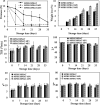Enhancing Gas Transmission Rate of PBS/PBAT Composite Films: A Study on Microperforated Film Solutions for Mango Storage
- PMID: 38284002
- PMCID: PMC10809366
- DOI: 10.1021/acsomega.3c06999
Enhancing Gas Transmission Rate of PBS/PBAT Composite Films: A Study on Microperforated Film Solutions for Mango Storage
Abstract
This study focused on improving the mechanical properties of the poly(butylene succinate) (PBS) film by incorporation of poly(butyrate adipate terephthalate) (PBAT). At 20 wt % PBAT, elongation in the transverse direction improved by 373% while maintaining high tensile strength (27 MPa) and Young's modulus (262 MPa). The PBS80/PBAT20 composite film exhibited optimized mechanical properties. The absorbance coefficient of microperforated film at 980/cm for the 80PBS/20PBAT mix, corresponding to the 10.2 μm CO2 laser wavelength, was 65/cm, indicating high film capability to absorb energy from the CO2 laser. The introduction of microholes enhanced the gas permeability of the PBS/PBAT film. As fluences increased from 187 to 370 J/cm2, there was a notable increase in microhole area in 80PBS/20PBAT film from 19,375 to 46,421 μm2. Concurrently, the gas transmission rate for a singular hole increased from 45 to 210 cm3/d for the oxygen transmission rate (OTR) and from 115 to 220 cm3/d for the CO2 transmission rate (CO2TR). For mango packed in microperforated 80PBS/20PBAT films, the O2 levels inside the package gradually dropped and remained at 14.2% in PBS80/PBAT20-MP1 (OTR ∼ 68,900 cm3/m2·d) and 16.7% in PBS80/PBAT20-MP2 (OTR ∼ 131,900 cm3/m2·d), while CO2 content increased to 6% for PBS80/PBAT20-MP1 and 4% for PBS80/PBAT20-MP2 throughout 33 days. On day 2 of storage in the nonperforated package, O2 content dropped to 2% while CO2 content rose to 22%. Mango packed in the 80PBS/20PBAT film package exhibited an unsatisfactory freshness quality due to the detection of a fermentative odor on day 5 of the storage period. Total soluble solids, color, and weight loss of mango remained stable during storage in all microperforated films. Results demonstrated that the mango shelf life was significantly extended by 35 days using 80PBS/20PBAT-MP1. Laser perforation offered a practical method for improving gas transmission rates (OTR and CO2TR) of 80PBS/20PBAT film for mango packaging.
© 2024 The Authors. Published by American Chemical Society.
Conflict of interest statement
The authors declare no competing financial interest.
Figures






References
-
- Belay Z. A.; Caleb O. J.; Opara U. L. Modelling approaches for designing and evaluating the performance of modified atmosphere packaging (MAP) systems for fresh produce: A review. Food Packaging and Shelf Life 2016, 10, 1–15. 10.1016/j.fpsl.2016.08.001. - DOI
-
- Winotapun C.; Aontee A.; Inyai J.; Pinsuwan B.; Daud W. Laser perforation of polyethylene terephthalate/polyethylene laminated film for fresh produce packaging application. Food Packaging and Shelf Life 2021, 28, 100677.10.1016/j.fpsl.2021.100677. - DOI
-
- Winotapun C.; Issaraseree Y.; Sirirutbunkajal P.; Leelaphiwat P. CO2 laser perforated biodegradable films for modified atmosphere packaging of baby corn. Journal of Food Engineering 2023, 341, 111356.10.1016/j.jfoodeng.2022.111356. - DOI
-
- Mistriotis A.; Briassoulis D.; Giannoulis A.; D’Aquino S. Design of biodegradable bio-based equilibrium modified atmosphere packaging (EMAP) for fresh fruits and vegetables by using micro-perforated poly-lactic acid (PLA) films. Postharvest Biology and Technology 2016, 111, 380–389. 10.1016/j.postharvbio.2015.09.022. - DOI
-
- Mahajan P. V.; Oliveira F. A. R.; Montanez J. C.; Frias J. Development of user-friendly software for design of modified atmosphere packaging for fresh and fresh-cut produce. Innovative Food Science & Emerging Technologies 2007, 8 (1), 84–92. 10.1016/j.ifset.2006.07.005. - DOI
LinkOut - more resources
Full Text Sources
Research Materials
